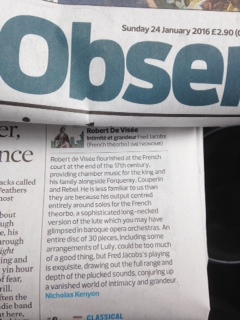
Robert de Visée INTIMITÉ ET GRANDEUR
Are you missing Downton Abbey?… Maybe not… but if so “Versailles” is about to become the latest TV period blockbuster on ITV screens in 2016. It remains to be seen whether period soaps à la Française will be such a hit with the British and American audiences but if you want to know a bit more about the real music of Louis XIV’s court rather than the bodice ripping accompaniments of bare-chested stallions in ruffs and frou-frou, this recording is for you.
The 300th Anniversary of the Death of The Sun King (September 1715 – December 2015) is celebrated by Fred Jacobs and Metronome with the completion of the 3rd and final volume of the Collected work of Music for Theorbo of “La Chambre du Roy” composer Robert de Visée.
The first composer names of Louis XIV’s dazzling court at Versailles that tend to spring to mind are Lully and Couperin but among the most intimate of his musicians was his Master of Theorbo and Guitar, Robert de Visée to whose work for theorbo this new release is devoted. The theorbo was an impressive plucked instrument that offered a huge range both of pitch and expression, a reflective subtlety and sophistication of sound. Towards the end of Louis’ reign after Lully’s death in 1687 the fashion moved away from the grandeur of the great operatic showcases to music of intimate expressiveness… the theorbo rose to this challenge and had its moment in the sun.
The fount of De Visée’s music is the “Contredanse”, a transliteration of the English words for country dance which had been introduced by an English Dancing Master to the ladies of the court in 1684 and became the rage.
Not long after De Visee’s death the theorbo passed into obscurity, and no instruments survive to the extent that the exact shape and structure of the instrument was unknown. Michael Lowe, and English lute maker based near Oxford, whose skill and researches allowed this instrument to be built on which this recording is made writes in the booklet which accompanies the recording about how he traced the instrument from surviving paintings (an important one came up for auction in London recently). It should change the composition of baroque authentic instrument orchestras
Fred Jacobs is one of the modern performing masters of this extra-ordinary instrument. Dramatic to look at as well as to listen to, Fred plays it in recital to accompany singers (on Metronome a release of Michel Lambert’s Air de Cours with Charles Daniels) and many of the leading baroque orchestras and opera houses in Europe (notably the Gabrieli Consort, the Locke Consort which he founded, the Parley of Instruments etc.)
Fred is based in Holland where he teaches at the Amsterdam Conservatoire.
This recording is the third and final one in a series which recorded the Collected Works for Theorbo of Robert De Visée’s.
Volume 1: Pièces de théorbe METCD 1072
Volume 2: Confidences galantes METCD 1089
Are you missing Downton Abbey?… Maybe not… but if so “Versailles” is about to become the latest TV period blockbuster on ITV screens in 2016. It remains to be seen whether period soaps à la Française will be such a hit with the British and American audiences but if you want to know a bit more about the real music of Louis XIV’s court rather than the bodice ripping accompaniments of bare-chested stallions in ruffs and frou-frou, this recording is for you.
The 300th Anniversary of the Death of The Sun King (September 1715 – December 2015) is celebrated by Fred Jacobs and Metronome with the completion of the 3rd and final volume of the Collected work of Music for Theorbo of “La Chambre du Roy” composer Robert de Visée.
The first composer names of Louis XIV’s dazzling court at Versailles that tend to spring to mind are Lully and Couperin but among the most intimate of his musicians was his Master of Theorbo and Guitar, Robert de Visée to whose work for theorbo this new release is devoted. The theorbo was an impressive plucked instrument that offered a huge range both of pitch and expression, a reflective subtlety and sophistication of sound. Towards the end of Louis’ reign after Lully’s death in 1687 the fashion moved away from the grandeur of the great operatic showcases to music of intimate expressiveness… the theorbo rose to this challenge and had its moment in the sun.
The fount of De Visée’s music is the “Contredanse”, a transliteration of the English words for country dance which had been introduced by an English Dancing Master to the ladies of the court in 1684 and became the rage.
Not long after De Visee’s death the theorbo passed into obscurity, and no instruments survive to the extent that the exact shape and structure of the instrument was unknown. Michael Lowe, and English lute maker based near Oxford, whose skill and researches allowed this instrument to be built on which this recording is made writes in the booklet which accompanies the recording about how he traced the instrument from surviving paintings (an important one came up for auction in London recently). It should change the composition of baroque authentic instrument orchestras
Fred Jacobs is one of the modern performing masters of this extra-ordinary instrument. Dramatic to look at as well as to listen to, Fred plays it in recital to accompany singers (on Metronome a release of Michel Lambert’s Air de Cours with Charles Daniels) and many of the leading baroque orchestras and opera houses in Europe (notably the Gabrieli Consort, the Locke Consort which he founded, the Parley of Instruments etc.)
Fred is based in Holland where he teaches at the Amsterdam Conservatoire.
This recording is the third and final one in a series which recorded the Collected Works for Theorbo of Robert De Visée’s.
Volume 1: Pièces de théorbe METCD 1072
Volume 2: Confidences galantes METCD 1089
